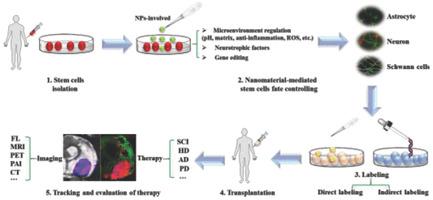当前位置:
X-MOL 学术
›
Adv. Mater.
›
论文详情
Our official English website, www.x-mol.net, welcomes your
feedback! (Note: you will need to create a separate account there.)
Nanomaterials in Neural‐Stem‐Cell‐Mediated Regenerative Medicine: Imaging and Treatment of Neurological Diseases
Advanced Materials ( IF 27.4 ) Pub Date : 2018-03-15 , DOI: 10.1002/adma.201705694 Bingbo Zhang 1, 2 , Wei Yan 3 , Yanjing Zhu 2 , Weitao Yang 1 , Wenjun Le 4 , Bingdi Chen 4 , Rongrong Zhu 2 , Liming Cheng 2
Advanced Materials ( IF 27.4 ) Pub Date : 2018-03-15 , DOI: 10.1002/adma.201705694 Bingbo Zhang 1, 2 , Wei Yan 3 , Yanjing Zhu 2 , Weitao Yang 1 , Wenjun Le 4 , Bingdi Chen 4 , Rongrong Zhu 2 , Liming Cheng 2
Affiliation

|
Patients are increasingly being diagnosed with neuropathic diseases, but are rarely cured because of the loss of neurons in damaged tissues. This situation creates an urgent clinical need to develop alternative treatment strategies for effective repair and regeneration of injured or diseased tissues. Neural stem cells (NSCs), highly pluripotent cells with the ability of self‐renewal and potential for multidirectional differentiation, provide a promising solution to meet this demand. However, some serious challenges remaining to be addressed are the regulation of implanted NSCs, tracking their fate, monitoring their interaction with and responsiveness to the tissue environment, and evaluating their treatment efficacy. Nanomaterials have been envisioned as innovative components to further empower the field of NSC‐based regenerative medicine, because their unique physicochemical characteristics provide unparalleled solutions to the imaging and treatment of diseases. By building on the advantages of nanomaterials, tremendous efforts have been devoted to facilitate research into the clinical translation of NSC‐based therapy. Here, recent work on emerging nanomaterials is highlighted and their performance in the imaging and treatment of neurological diseases is evaluated, comparing the strengths and weaknesses of various imaging modalities currently used. The underlying mechanisms of therapeutic efficacy are discussed, and future research directions are suggested.
中文翻译:

神经干细胞介导的再生医学中的纳米材料:神经疾病的成像和治疗
越来越多的患者被诊断出患有神经性疾病,但由于受损组织中神经元的丢失而很少治愈。这种情况引起了迫切的临床需求,以开发替代治疗策略来有效修复和再生受伤或患病的组织。神经干细胞(NSC)是具有自我更新能力和多向分化潜能的高度多能细胞,为满足这一需求提供了有希望的解决方案。然而,尚待解决的一些严峻挑战是调节植入的NSC,追踪其命运,监测其与组织环境的相互作用和对组织环境的反应以及评估其治疗效果。纳米材料已被设想为创新成分,可进一步增强基于NSC的再生医学领域的实力,因为它们独特的理化特性为疾病的成像和治疗提供了无与伦比的解决方案。通过利用纳米材料的优势,我们付出了巨大的努力来促进对基于NSC的疗法的临床翻译的研究。在此,重点介绍了有关新兴纳米材料的最新工作,并比较了当前使用的各种成像方式的优缺点,评估了它们在神经系统疾病的成像和治疗中的性能。讨论了治疗功效的潜在机制,并提出了未来的研究方向。为了促进对基于NSC的疗法的临床翻译的研究,我们付出了巨大的努力。在此,重点介绍了有关新兴纳米材料的最新工作,并比较了当前使用的各种成像方式的优缺点,评估了它们在神经系统疾病的成像和治疗中的性能。讨论了治疗功效的潜在机制,并提出了未来的研究方向。为了促进对基于NSC的疗法的临床翻译的研究,我们付出了巨大的努力。在此,重点介绍了有关新兴纳米材料的最新工作,并比较了当前使用的各种成像方式的优缺点,评估了它们在神经系统疾病的成像和治疗中的性能。讨论了治疗功效的潜在机制,并提出了未来的研究方向。
更新日期:2018-03-15
中文翻译:

神经干细胞介导的再生医学中的纳米材料:神经疾病的成像和治疗
越来越多的患者被诊断出患有神经性疾病,但由于受损组织中神经元的丢失而很少治愈。这种情况引起了迫切的临床需求,以开发替代治疗策略来有效修复和再生受伤或患病的组织。神经干细胞(NSC)是具有自我更新能力和多向分化潜能的高度多能细胞,为满足这一需求提供了有希望的解决方案。然而,尚待解决的一些严峻挑战是调节植入的NSC,追踪其命运,监测其与组织环境的相互作用和对组织环境的反应以及评估其治疗效果。纳米材料已被设想为创新成分,可进一步增强基于NSC的再生医学领域的实力,因为它们独特的理化特性为疾病的成像和治疗提供了无与伦比的解决方案。通过利用纳米材料的优势,我们付出了巨大的努力来促进对基于NSC的疗法的临床翻译的研究。在此,重点介绍了有关新兴纳米材料的最新工作,并比较了当前使用的各种成像方式的优缺点,评估了它们在神经系统疾病的成像和治疗中的性能。讨论了治疗功效的潜在机制,并提出了未来的研究方向。为了促进对基于NSC的疗法的临床翻译的研究,我们付出了巨大的努力。在此,重点介绍了有关新兴纳米材料的最新工作,并比较了当前使用的各种成像方式的优缺点,评估了它们在神经系统疾病的成像和治疗中的性能。讨论了治疗功效的潜在机制,并提出了未来的研究方向。为了促进对基于NSC的疗法的临床翻译的研究,我们付出了巨大的努力。在此,重点介绍了有关新兴纳米材料的最新工作,并比较了当前使用的各种成像方式的优缺点,评估了它们在神经系统疾病的成像和治疗中的性能。讨论了治疗功效的潜在机制,并提出了未来的研究方向。











































 京公网安备 11010802027423号
京公网安备 11010802027423号